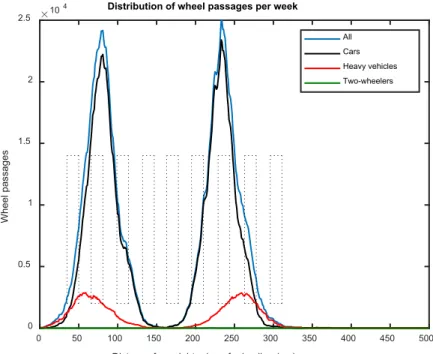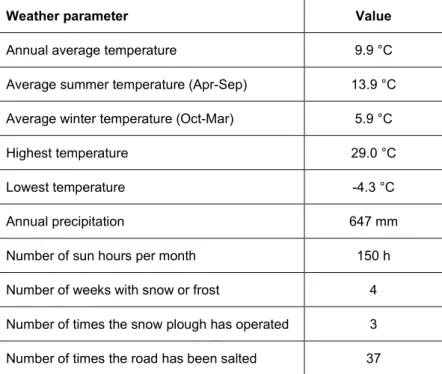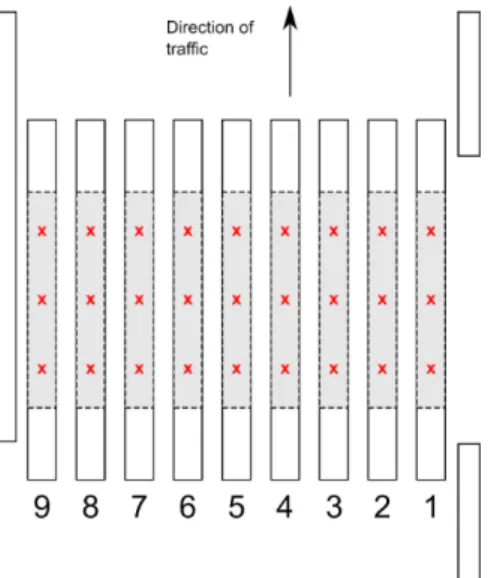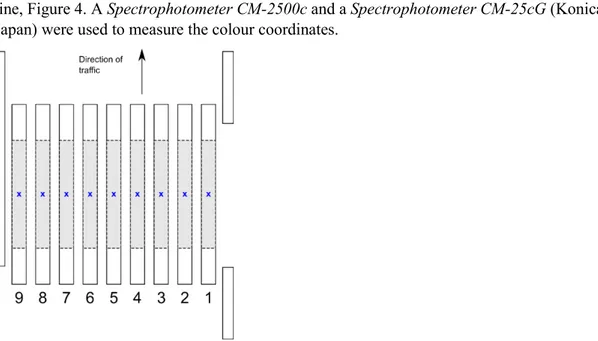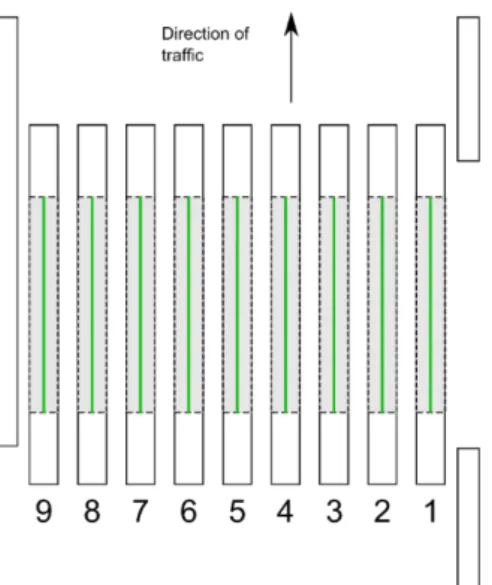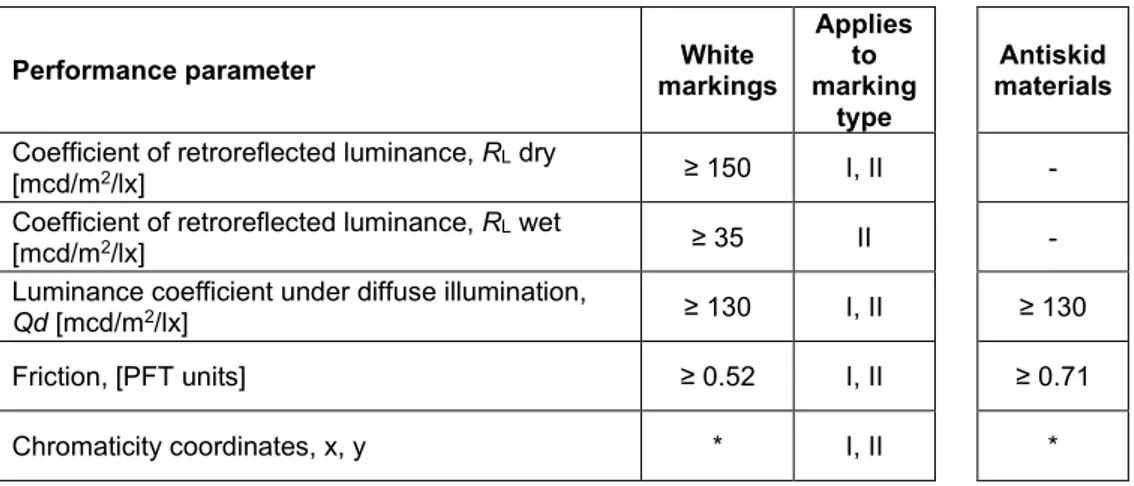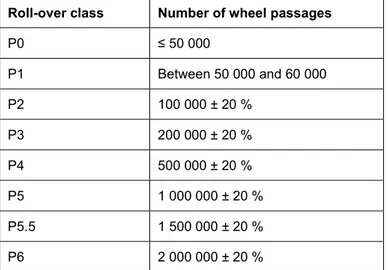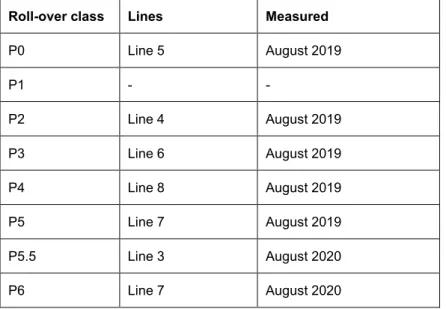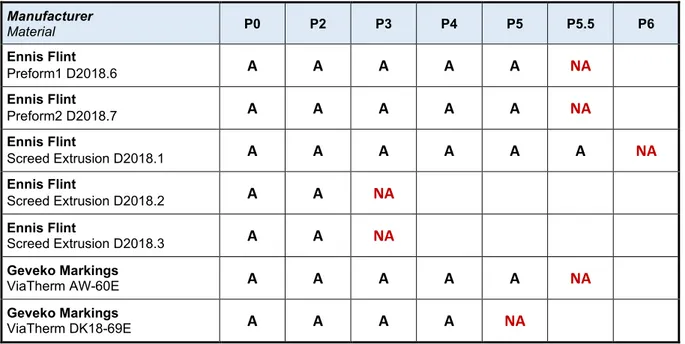VTI rapport 1065A Published 2020 vti.se/publications
Nordic certification of road
marking materials in Denmark
2018–2020
Trond Cato Johansen Carina Fors
VTI rapport 1065A
Nordic certification of
road marking materials
in Denmark 2018–2020
Trond Cato Johansen
Carina Fors
Author: Trond Cato Johansen (Ramboll), Carina Fors (VTI) Reg. No., VTI: 2019/0327-8.4
Publication: VTI rapport 1065A Published by VTI, 2020
Publikationsuppgifter – Publication Information
Titel/Title
Nordisk certifiering av vägmarkeringsmaterial i Danmark 2018–2020 Nordic certification of road marking materials in Denmark 2018–2020
Författare/Author
Trond Cato Johansen (Ramboll)
Carina Fors (VTI, http://www.orcid.org/0000-0002-2061-5817)
Utgivare/Publisher
VTI, Statens väg- och transportforskningsinstitut
Swedish National Road and Transport Research Institute (VTI)
www.vti.se/
Serie och nr/Publication No.
VTI rapport 1065A
Utgivningsår/Published
2020
VTI:s diarienr/Reg. No., VTI
2019/0327-8.4
ISSN
0347–6030
Projektnamn/Project
Nordisk certifiering av vägmarkeringsmaterial – danskt provfält 2019 Nordic certification of road marking materials – Danish test field 2019
Uppdragsgivare/Commissioned by
Trafikverket i Danmark, Island, Norge och Sverige/ The National Road Administrations in Denmark, Iceland, Norway and Sweden
Språk/Language
Engelska/English
Antal sidor inkl. bilagor/No. of pages incl. appendices
4 VTI rapport 1065A
Abstract
A Nordic certification system for road marking materials, that applies to the countries of Denmark, Iceland, Norway and Sweden, was introduced in 2015. In these countries, a documented product approval is required in order to use a road marking material on roads managed by the national road authorities. A product approval is based on monitored and documented performance measurements of material samples applied on test fields on public roads. The materials are approved (certified) in relation to the number of wheel passages they will stand, with preserved function.
The certification system includes road marking materials for longitudinal and transverse road markings in categories with respect to colour (white, yellow), type (type I, type II, type II inlaid, antiskid, hand application, non-reflective with enhanced durability, and temporary) and thickness (0.4, 0.6, 1.5, 3 and 5 mm).
The present report documents the follow-up performance measurements that were carried out at the Danish test site in 2020, i.e. one-year follow-up measurements for materials applied in 2019 and the two year follow-up measurements for materials applied in 2018. The performance parameters include the coefficient of retroreflected luminance (RL) under dry and wet conditions, the luminance
coefficient under diffuse illumination (Qd), the friction, and the chromaticity in daylight.
Keywords
Referat
En nordisk certifiering av vägmarkeringsmaterial introducerades 2015 och omfattar för närvarande Danmark, Island, Norge och Sverige. I dessa länder krävs ett dokumenterat godkännande av väg-markeringsmaterial som används på vägar som administreras av den statliga väghållaren. Detta godkännande baseras på funktionsmätningar på materialprover som har applicerats på provfält på allmän väg. Materialen godkänns (certifieras) i relation till antalet hjulpassager de klarar med bibehållen funktion.
Certifieringssystemet omfattar vägmarkeringsmaterial för längsgående och tvärgående vägmarkeringar i olika kategorier med avseende på färg (vit, gul), typ (typ I, typ II, nedfräst typ II, friktion, hand-läggning, slitstarka icke-reflekterande samt temporära) och tjocklek (0,4; 0,6; 1,5; 3 och 5 mm). Föreliggande rapport dokumenterar resultaten från de uppföljande funktionsmätningar som gjordes på det danska provfältet 2020, det vill säga ettårsuppföljning av material som lades ut 2019 och tvåårs-uppföljning av material som lades ut 2018. Funktionsmätningarna omfattar retroreflexion (RL) i torrt
och vått tillstånd, luminanskoefficient (Qd), friktion och färg i dagsljus.
Nyckelord
Preface
A Nordic certification system for road marking materials was introduced in 2015. A certification of products is based on documented performance measurements of material samples applied on test fields on public roads. This report compiles and presents the results of the performance measurements carried out in 2020 on road marking materials applied for certification at the Danish test site in 2018– 2019.
Performance measurements of retroreflection, luminance coefficient, friction and chromaticity coordinates were carried out by operators from Ramboll, supervised by staff from VTI.
The road trials are administered as a joint project between Ramboll and the Swedish National Road and Transport Research Institute (VTI). Trond Cato Johansen at Ramboll is the project manager and Carina Fors is the project leader at VTI. Michael Ruben Anker Larsen, the Danish Road Directorate, Ásbjörn Ólafsson, the Icelandic Road and Coastal Administration, Bjørn Skaar, the Norwegian Public Roads Administration and Ulf Söderberg, the Swedish Transport Administration constitute a steering committee for the Nordic certification system.
Drammen, September 2020
Trond Cato Johansen Project Manager
8 VTI rapport 1065A
Quality review
An internal peer review was conducted on 11 October 2020 by Anna Anund. Carina Fors has made adjustments to the final report. Research Director Anna Anund has thereafter reviewed and approved the report for publication on 16 October 2020. The conclusions and recommendations in the report are those of the authors and do not necessarily reflect the views of VTI as a government agency.
Kvalitetsgranskning
Intern peer review har genomförts 11 oktober 2020 av Anna Anund. Carina Fors har genomfört justeringar av slutligt rapportmanus. Forskningschef Anna Anund har därefter granskat och godkänt publikationen för publicering 16 oktober 2020. De slutsatser och rekommendationer som uttrycks är författarnas egna och speglar inte nödvändigtvis myndigheten VTI:s uppfattning.
Contents
Publikationsuppgifter – Publication Information ...3
Abstract ...4 Referat ...5 Preface ...7 Quality review ...8 Kvalitetsgranskning ...8 Summary ...11 Sammanfattning ...13 1. Introduction ...15 1.1. Aim ...15 2. Test site ...16 2.1. General ...16 2.2. Material application ...16
2.3. Traffic volume and wheel passages ...17
2.4. Weather conditions 2019–2020...18
3. Performance measurements ...19
3.1. General ...19
3.2. Methods and measuring instruments ...19
3.2.1. Coefficient of retroreflected luminance RL and luminance coefficient under diffuse illumination Qd ...19
3.2.2. Chromaticity coordinates ...20
3.2.3. Friction ...20
3.2.4. Measurement values that do not fulfil the performance requirements ...21
3.3. Weather conditions ...21
4. Performance requirements ...22
4.1. Performance parameters ...22
4.1.1. Special considerations regarding friction ...22
4.2. Certification in relation to P-classes ...22
4.2.1. P-classes at the Danish test site 2020 ...23
5. Certification of materials applied in 2018 ...25
5.1. White road markings ...25
5.1.1. Type I ...25
5.1.2. Type II ...26
5.2. Summary of the results ...26
5.2.1. White materials ...27
6. Certification of materials applied in 2019 ...28
6.1. White road markings ...28
6.1.1. Type I ...28
6.1.2. Type II ...29
6.2. Summary of the results ...29
10 VTI rapport 1065A
7. Summary of materials certified for use in Denmark ...31
7.1. White type I materials ...31
7.2. White type II materials ...32
7.3. White antiskid materials ...32
References ...33
Summary
Nordic certification of road marking materials in Denmark 2018–2020
by Trond Cato Johansen (Ramboll) and Carina Fors (VTI)
A Nordic certification system for road marking materials, that applies to the countries of Denmark, Iceland, Norway and Sweden, was introduced in 2015. In these countries, a documented product approval is required in order to use a road marking material on roads managed by the national road authorities. A product approval is based on monitored and documented performance measurements of material samples applied on test fields on public roads. A certification in Denmark is based on the results from a test site in Denmark and a certification in Iceland, Norway and Sweden is based on the results from a test site in Norway or in Sweden. The certification system includes road marking materials for longitudinal and transverse road markings in categories with respect to colour (white, yellow), type (type I, type II, type II inlaid, antiskid, hand application, non-reflective with enhanced durability, and temporary) and thickness (0.4, 0.6, 1.5, 3 and 5 mm).
A Danish test site was established in autumn 2015, where between 13 and 32 materials have been applied yearly since then. Approximately two weeks after application, the initial performance of the coefficient of retroreflected luminance RL under dry and wet conditions, the luminance coefficient
under diffuse illumination Qd, the friction and the chromaticity in daylight are determined.
Follow-up measurements of the performance parameters mentioned above are carried out one and two years after application. The present report documents the follow-up measurements that were carried out in 2020, i.e. one-year follow-up measurements for materials applied in 2019 and the two years follow-up measurements for materials applied in 2018.
Materials are certified in relation to the number of wheel passages they will stand, with preserved functionality. Depending on the traffic flow, the position in the lane and the exposure time, different roll-over classes (P0–P6, corresponding to ≤50 000–2 000 000 wheel passages, defined by EN 1824) will be reached. For materials applied in 2019, roll-over classes P0, P3, P4 and P5 were reached in 2020 and for materials applied in 2018, roll-over classes P5.5 and P6 were reached in 2020.
Out of the 18 materials applied for certification in 2019, all were approved at the initial measurements and did thus qualify for follow-up measurements. Out of the 18 materials, 1 fulfilled the requirement for roll-over class P5, 6 for class P4, 7 for class P3 and 15 for class P0. Three materials did not fulfil the requirements for any roll-over class.
Seven materials applied in 2018 fulfilled the requirement for class P5 in 2019. The follow-up measurements carried out in 2020 showed that 1 of these materials fulfilled the requirement for class P5.5. No material fulfilled the requirement for class P6. Thus, the final result for the 13 materials applied in 2018 is as follows: • No P-class: 1 material • P0: 12 materials • P2: 12 materials • P3: 10 materials • P4: 9 materials • P5: 7 materials • P5.5: 1 material • P6: 0 materials.
Sammanfattning
Nordisk certifiering av vägmarkeringsmaterial i Danmark 2018–2020
av Trond Cato Johansen (Ramboll) och Carina Fors (VTI)
En nordisk certifiering av vägmarkeringsmaterial introducerades 2015 och avser för närvarande Danmark, Island, Norge och Sverige. I dessa länder krävs ett dokumenterat godkännande av väg-markeringsmaterial som används på vägar som administreras av den statliga väghållaren. Detta godkännande baseras på funktionsmätningar på vägmarkeringar som har applicerats på provfält på allmän väg. Certifiering i Danmark baseras på resultat från provfält i Danmark, medan certifiering i Island, Norge och Sverige baseras på resultat från provfält i Norge eller i Sverige. Certifierings-systemet omfattar vägmarkeringsmaterial för längsgående och tvärgående vägmarkeringar i olika kategorier med avseende på färg (vit, gul), typ (typ I, typ II, nedfräst typ II, friktion, handläggning, slitstarka icke-reflekterande samt temporära) och tjocklek (0,4; 0,6; 1,5; 3 och 5 mm).
Ett danskt provfält etablerades hösten 2015, där mellan 13 och 32 material har lagts ut för provning varje år sedan dess. Cirka två veckor efter utläggningen görs initiala mätningar av vägmarkeringarnas retroreflexion, RL i torrt och vått tillstånd, luminanskoefficient, Qd, friktion och färg i dagsljus.
Uppföljande mätningar av ovan nämnda funktionsparametrar görs ett respektive två år efter
utläggning. Föreliggande rapport dokumenterar resultaten från de uppföljande mätningar som gjordes 2020, det vill säga ettårsuppföljning av material som lades ut 2019 och tvåårsuppföljning av material som lades ut 2018.
Materialen certifieras i relation till antalet hjulpassager de tål med bibehållen funktion. Beroende på trafikflöde, position i körfältet och exponeringstid, uppnås olika hjulpassageklasser (P0–P6,
motsvarande ≤50 000–2 000 000 hjulpassager) som definieras av europastandarden EN 1824. På provfältet som lades ut 2019 uppnåddes klasserna P0, P3, P4 och P5 under 2020 och på provfältet som lades ut 2018 uppnåddes klasserna P5.5 och P6 under 2020.
Av de 18 material som lades ut 2019 godkändes samtliga vid de initiala mätningarna och de kvalificerade sig därmed för uppföljande mätningar. Av de 18 materialen uppfyllde 1 kraven för hjulpassageklass P5, 6 för klass P4, 7 för klass P3 och 15 för klass P0. Tre material uppfyllde inte kraven för någon hjulpassageklass.
Sju material som lades ut 2018 uppfyllde kraven för klass P5 under 2019. De uppföljande mätningarna som gjordes 2020 visade att 1 av dessa material uppfyllde kraven för klass P5.5. Inget av materialen uppfyllde kraven för klass P6. De slutgiltiga resultaten för de 13 material som lades ut för certifiering 2018 är således:
• Ingen P-klass: 1 material • P0: 12 material • P2: 12 material • P3: 10 material • P4: 9 material • P5: 7 material • P5.5: 1 material • P6: 0 material.
1.
Introduction
A Nordic certification system for road marking materials, NordicCert, that applies to the countries of Denmark, Iceland, Norway and Sweden, was introduced in 2015. In these countries, a documented product approval is required in order to use a road marking material on roads managed by the national road authorities. Product approval is based on monitored and documented performance measurements of material samples applied on test fields on public roads. Certification in Denmark is based on the results from a test site in Denmark and certification in Iceland, Norway and Sweden is based on the results from a test site in Norway or in Sweden. The results from the Icelandic-Norwegian-Swedish test site are presented in a separate report (Johansen and Fors, 2020).
The first round of material tests in Denmark started in October 2015, at a test site located in Hornbæk. In 2016, a new Danish test site was established close to Gørlev, where new materials have been applied yearly since then (except for 2020). In total 106 materials, whereof 96 for certification and 10 for manufacturer’s internal test, have been applied at the Danish test sites.
Follow-up measurements of the performance parameters coefficient of retroreflected luminance RL
under dry and wet conditions, luminance coefficient under diffuse illumination Qd, chromaticity in daylight and friction are carried out one year and two years after application. Thus, in 2020, two-years follow-up measurements for materials applied in 2018 and one-year follow-up measurements for materials applied in 2019 were carried out.
Materials are certified in relation to the number of wheel passages they will stand. Measurements of the transversal distribution of wheel passages have been carried out at the test sites, and roll-over classes (P-classes, defined by EN 1824) have been determined for each of the nine lines of road marking materials that were applied in the lane (see also Section 2.2). For materials applied at the Danish test site in 2018, the P-classes P0, P2, P3, P4 and P5 were reached in 2019 and P-classes P5.5 and P6 were reached in 2020. For materials applied at the Danish test site in 2019, the P-classes P0, P3, P4 and P5 were reached in 2020.
The certification system is further described in the document Nordic certification system for road marking materials – Version 7:2020 (Fors and Johansen, 2020) which is a public report available at www.vti.se/en/publications and at www.nordiccert.com.
Lists of certified materials from 2015 onwards are available at www.nordiccert.com.
1.1. Aim
The aim of this report is to compile and present the results of the follow-up performance
measurements carried out in 2020 on the materials applied at the Danish test site in 2018 and in 2019, i.e. the report presents which materials have been certified for use in Denmark, for the P-classes mentioned above. Results for higher P-classes for materials applied in 2019 will be published after the two-years follow-up measurements in 2021.
The report includes results of materials registered as certification materials. Results of materials registered as test materials will be available only to the specific manufacturer. Result reports for materials applied in 2015–2017 are available at www.nordiccert.com.
16 VTI rapport 1065A
2.
Test site
The test site in Gørlev, Denmark, was established in 2016. Materials have been applied in 2016, 2017, 2018 and 2019.
2.1. General
The road used for the test site is a two-lane rural road surrounded by an open landscape, Figure 1. The road is relatively straight and flat and without any major junctions. It has an annual average daily traffic (AADT) of around 8 100 vehicles/day and the posted speed limit is 80 km/h. The width of the road is 7.1 m and each lane is 3.30 m wide. The road surface consists of asphalt of type SMA8 that was placed in 2015. The averaged mean texture depth (MTD) is approximately 0.67 mm, i.e. the roughness class is RG2.
Figure 1. The road used for the Danish test site in Gørlev (photo: Trond Cato Johansen, Ramboll). The Köppen (climatic) classification of the test site is Cfb, based on data for the period 1951–2000 (Kottek, Grieser, Beck, Rudolf and Rubel, 2006). The climatic class of the Danish test site according to the European Standard EN 1824 is C3, i.e. Cfb with winter maintenance. The extent of winter maintenance may vary a lot between years.
Studded tyres are permitted in Denmark from 1 November to 15 April. However, the percentage of cars with studded tyres is low (estimation: about 5 %).
Further details can be found in Fors and Johansen (2020).
2.2. Material application
Each marking material was applied as a row of nine longitudinal lines in the direction of the traffic. The length of the lines was 2.5 m and the width was 0.15 m. The distance between two adjacent rows of lines was at least 2 m. The lines are numbered from right to left in the driving direction, i.e. line 1 is the one next to the edge line and line 9 is the one next to the centre line.
2.3. Traffic volume and wheel passages
Measurements of wheel passages are carried out yearly, in order to determine roll-over classes (P-classes) for the lines, see also Section 4.2. The results of the 2019 wheel passage measurements, which apply to the testfield established in 2019 are presented below, while the results of the 2018
measurements, which apply to the testfield established in 2018 can be found in Johansen and Fors (2019).
The number and type of vehicles and their lateral position were registered by a portable traffic
analyser based on coaxial cable technique, developed at VTI. The measurement equipment was placed in the south end of the test field applied in 2019. Wheel passages were registered for one week. On average, 91.3 % of the registered vehicles were passenger cars, 8.4 % were heavy vehicles (trucks and buses) and 0.3 % were other vehicles (two-wheelers and working vehicles). The registered number of vehicles were adjusted so that it corresponded to the annual average daily traffic (AADT) of 3 924 vehicle per lane, provided by the Danish road directorate.
Figure 2 shows the distribution of wheel passages for the average week.
Figure 2. Wheel passages per week at the Danish test field established in 2019 in Gørlev. The dashed areas correspond to the nine lines. Please note that the shoulder is to the left in the figure, i.e. line 1 is the leftmost line. The number of two-wheelers is too few to be visible in the figure.
Table 1 shows the number of wheel passages per line and week for the test field of 2019, as an average for the 15 cm wide lines (corresponding to the measurement area, see Figure 3–Figure 5).
Table 1. Number of wheel passages per line and week, at the test field of 2019 in Gørlev. Line 1 is the one next to the edge line, see also Figure 3.
Line Line 1 Line 2 Line 3 Line 4 Line 5 Line 6 Line 7 Line 8 Line 9
Number of wheel passages per week
4 258 22 142 7 407 380 164 5 506 24 161 7 081 541
The lines relevant for P-classes P5.5 and P6 on the test field of 2018 – line 3 and line 7 – had 16 236 and 19 965 wheel passages per week, respectively.
0 50 100 150 200 250 300 350 400 450 500
Distance from right edge of edge line (cm)
0 0.5 1 1.5 2 2.5 Wheel passages
104 Distribution of wheel passages per week
All Cars Heavy vehicles Two-wheelers
18 VTI rapport 1065A
2.4. Weather conditions 2019–2020
The weather conditions from August 2019 to August 2020 are shown in Table 2.
Table 2. Weather conditions at the Danish test site in Gørlev, from August 2019 to August 2020.
Weather parameter Value
Annual average temperature 9.9 °C
Average summer temperature (Apr-Sep) 13.9 °C
Average winter temperature (Oct-Mar) 5.9 °C
Highest temperature 29.0 °C
Lowest temperature -4.3 °C
Annual precipitation 647 mm
Number of sun hours per month 150 h
Number of weeks with snow or frost 4
Number of times the snow plough has operated 3
Number of times the road has been salted 37
Weather data was retrieved from the Danish Meteorological Institute (DMI), at the following places: Flakkebjerg approximately 28 km south of the test site (temperature, sun hours, snow/frost) and Rye close to the test site (precipitation). Information about snow plough operations and salting was obtained from the Danish road directorate.
3.
Performance measurements
3.1. General
Measurements of all performance parameters were carried out by operators from Ramboll, supervised by an observer from VTI. All measurement equipment was calibrated according to procedures recommended by the respective manufacturer.
Performance measurements were carried out in August 2020.
3.2. Methods and measuring instruments
3.2.1. Coefficient of retroreflected luminance R
Land luminance coefficient under
diffuse illumination Qd
The coefficient of retroreflected luminance, RL, and the luminance coefficient under diffuse
illumination, Qd, were measured using an LTL-XL (Delta, Denmark). Measurements were taken at three points along the centre line, Figure 3. The result of an individual line was calculated as the average of the three measurements.
The coefficient of retroreflected luminance, RL, under wet conditions was measured on type II
markings (i.e. road markings with special properties intended to enhance the retroreflection in wet or rainy conditions), with the same instrument and measurement points as described above.
Approximately 3 litres of clean water were poured over the measurement area, and measurements were carried out 60 seconds afterwards.
Figure 3. The measurement points (red crosses) for RL and Qd were placed along the centre line
within the measurement area (grey) defined by EN 1824.
The markings were not cleaned before the measurements, but in case a substantial part of the
measurement area was abnormally dirty (e.g. oil stain), the instrument was moved in the longitudinal direction to the closest area not affected by abnormal dirt.
Some marking lines were too worn to be measured. If the measurement area of the marking lines were worn in a way that made representative measurements impossible, these single lines were not
measured. However, other marking lines of the same product, that were not equally worn, were measured.
20 VTI rapport 1065A
3.2.2. Chromaticity coordinates
Chromaticity (colour) coordinates were measured in one point on each line, located at the centre of the line, Figure 4. A Spectrophotometer CM-2500c and a Spectrophotometer CM-25cG (Konica Minolta, Japan) were used to measure the colour coordinates.
Figure 4. The measurement points (blue crosses) for chromaticity coordinates were placed in the centre of the lines.
For materials with a high degree of wear, the measurement was taken at an area where the material was intact, if possible. For materials that had a very non-homogenous surface (due to unevenly distributed drop-on), an area that appeared to represent the average surface of the material was selected as measurement point. In some cases, several measurement points were selected, to ensure correct chromaticity coordinates. These points had to be located within the grey area in Figure 4. The markings were not cleaned before the measurements, but in case a substantial part of the
measurement area was abnormally dirty (e.g. oil stain), the instrument was moved to the closest area not affected by abnormal dirt.
3.2.3. Friction
Friction measurements were carried out using a Portable Friction Tester version 4, PFT (Coralba, Sweden), along the centre of each line, Figure 5. The PFT takes a sample approximately every 1.9 cm and thus, about 70 samples are taken on each line. The result of an individual line is calculated as the average of all samples from that line.
In case there were any notches, joints or other abnormalities on the marking surface, the measurement area/line was either reduced or moved somewhat, so that no samples were taken from the abnormality. Friction was measured on wetted markings. The friction measurements were always carried out after the measurements of the coefficient of retroreflected luminance, RL, the luminance coefficient under
diffuse illumination, Qd, and chromaticity coordinates. The PFT instrument is further described in Wälivaara (2007).
Figure 5. The measurement areas (green lines) for friction.
3.2.4. Measurement values that do not fulfil the performance requirements
In case a measured value was just below the performance requirement (see Section 4.1), extra measurements were taken to assure a correct result. If the new measurement values fulfilled the requirements, this was regarded as the final result and the material was thus approved with respect to that parameter. If the new measurements did not fulfil the requirements, the original measurement was regarded as the final result, i.e. the material was not approved.
3.3. Weather conditions
During the measurements, the weather was shifting between sunshine and cloudy. The air temperature was approximately 15˚ C (morning) – 20˚ C (day/evening). All performance measurements of RL,dry,
22 VTI rapport 1065A
4.
Performance requirements
4.1. Performance parameters
The performance requirements include four parameters for type I markings1, five parameters for type
II markings2 and three parameters for antiskid materials, which are given in Table 3.
Table 3. Performance requirements.
Performance parameter markings White
Applies to marking type Antiskid materials
Coefficient of retroreflected luminance, RL dry
[mcd/m2/lx] ≥ 150 I, II -
Coefficient of retroreflected luminance, RL wet
[mcd/m2/lx] ≥ 35 II -
Luminance coefficient under diffuse illumination,
Qd [mcd/m2/lx] ≥ 130 I, II ≥ 130
Friction, [PFT units] ≥ 0.52 I, II ≥ 0.71
Chromaticity coordinates, x, y * I, II *
*) According to EN 1436:2018
Regarding friction, a PFT value of 0.52 corresponds to an SRT value of 50 (class S2 in EN 1436), whereas a PFT value of 0.71 corresponds to an SRT value of 65 (S5). See also Section 4.1.1.
4.1.1. Special considerations regarding friction
A PFT value of 0.52 corresponds to a Skid Resistance Tester (SRT) value of 50. The translation from PFT units into SRT units and vice versa results in an uncertainty of approximately 10 % (Wälivaara, 2007). Consequently, there is a risk that a reading of a value just below 0.52 PFT units, in fact has 50 SRT units and therefore should fulfil the requirement.
In order to minimize the risk that materials are rejected because of the uncertainty when translating PFT units into SRT units, the required limit for approval was lowered by approximately 10 % or 0.05 PFT units, from 0.52 to 0.47 for type I and type II markings, and from 0.71 to 0.66 for antiskid materials.
4.2. Certification in relation to P-classes
Materials are certified in relation to the number of wheel passages they will stand. The nine lines within the driving lane are exposed to different numbers of wheel passages, which means that different roll-over classes are reached on different lines at different times.
Roll-over classes according to EN 1824 are determined from the measurements of wheel passages for each line, Table 4.
Materials are thus certified for a certain roll-over class (P-class). In order to be certified, all four (type I markings), five (type II markings) or three (antiskid materials) performance requirements must be fulfilled for that particular class.
1 Type I refers to flat markings.
2 Type II refers to markings with special properties intended to enhance the retroreflection in wet or rainy
Certification is given based on the follow-up measurements one and two years after application. No certification is given based on the initial measurements that are carried out a few weeks after application.
At the follow-up measurements, the performance parameters are defined as the registered value of the line which is the most representative of a certain P-class (see Section 4.2.1).
The materials have to fulfil the requirements for all classes lower than that it is certified for, provided that the lower classes exist on the test field. Example: In order for a material to be certified as a P3 material, the performance requirements have to be fulfilled also for classes P0, P1 and P2.
If a material has been certified for a certain P-class after one year (i.e. at the one-year follow-up measurement), this certification is valid irrespective of the results of the measurements after two years. The two-year follow-up measurements are merely used to evaluate whether the material fulfils the requirement for a higher P-class than what it is already certified for.
Table 4. Roll-over classes, EN 1824.
Roll-over class Number of wheel passages
P0 ≤ 50 000 P1 Between 50 000 and 60 000 P2 100 000 ± 20 % P3 200 000 ± 20 % P4 500 000 ± 20 % P5 1 000 000 ± 20 % P5.5 1 500 000 ± 20 % P6 2 000 000 ± 20 %
4.2.1. P-classes at the Danish test site 2020
For materials applied at the test site in Gørlev in 2018, P-classes P0, P2, P3, P4 and P5 were reached in 2019, and P-classes P5.5 and P6 were reached in 2020. For materials applied in 2019, P-classes P0, P3, P4 and P5 were reached in 2020 and P5.5 and P6 are expected to be reached in 2021. All P-classes were represented by one line, Table 5–Table 6.
24 VTI rapport 1065A Table 5. P-classes at the Danish test site in Gørlev, for materials applied in 2018.
Roll-over class Lines Measured
P0 Line 5 August 2019 P1 - - P2 Line 4 August 2019 P3 Line 6 August 2019 P4 Line 8 August 2019 P5 Line 7 August 2019 P5.5 Line 3 August 2020 P6 Line 7 August 2020
Table 6. P-classes at the Danish test site in Gørlev, for materials applied in 2019. Roll-over class Lines Measured
P0 Line 9 August 2020 P1 - - P2 - - P3 Line 1 August 2020 P4 Line 3 August 2020 P5 Line 2 August 2020 P5.5 - Summer 2021 (expected) P6 - Summer 2021 (expected)
5.
Certification of materials applied in 2018
Table 7–Table 8 show the certification of road marking materials in P-classes P0, P2, P3, P4, P5, P5.5 and P6 for materials applied at the test site in Gørlev in 2018. Ameans approved and NA not approved material. Empty cells imply that the material was not approved in a lower P-class.
Only materials that were approved at the initial measurements and that participate as certification materials with two years follow-up are included in the tables below.
Measurement data per material and P-class can be found in Appendix 1.
5.1. White road markings
5.1.1. Type I
5.1.1.1. Material thickness 3 mm
Table 7. Certification of road marking materials for use on Danish roads, roll-over classes P0, P2, P3, P4, P5, P5.5 and P6. White type I materials, 3 mm, applied in 2018.
Manufacturer Material P0 P2 P3 P4 P5 P5.5 P6 Ennis Flint Preform1 D2018.6 A A A A A NA Ennis Flint Preform2 D2018.7 A A A A A NA Ennis Flint Screed Extrusion D2018.1 A A A A A A NA Ennis Flint Screed Extrusion D2018.2 A A NA Ennis Flint Screed Extrusion D2018.3 A A NA Geveko Markings ViaTherm AW-60E A A A A A NA Geveko Markings ViaTherm DK18-69E A A A A NA
26 VTI rapport 1065A
5.1.2. Type II
5.1.2.1. Material thickness 5 mm
Table 8. Certification of road marking materials for use on Danish roads, roll-over classes P0, P2, P3, P4, P5, P5.5 and P6. White type II materials, 5 mm, applied in 2018.
Manufacturer Material P0 P2 P3 P4 P5 P5.5 P6 Ennis Flint Multidot D2018.5 Profile/pattern: Dots A A A A A NA Ennis Flint Profile1 D2018.8 Profile/pattern: Longflex A A A A A NA Ennis Flint Screed Extrusion D2018.4 Profile/pattern: Dots A A A A A NA Geveko Markings ViaTherm DK18-69 Agglo Profile/pattern: Agglo A A A A NA Geveko Markings ViaTherm DK26-62 Agglo Profile/pattern: Agglo A A A NA Geveko Markings ViaTherm DK34-65 LongDot Profile/pattern: LongDot NA
5.2. Summary of the results
Out of the 13 materials applied for certification at the Danish test site in Gørlev in 2018, 12 have received certification in one or more P-classes. The final result, including materials with one and two years follow-up, per material category and P-class is shown in Table 9.
Detailed results for P-classes P0–P5 can be found in the report Nordic certification of road marking materials in Denmark 2017–2019 (Johansen and Fors, 2019).
5.2.1. White materials
Table 9. Summary of the results for materials applied at the Danish test site in 2018. Number of certified materials per material category and P-class. White materials.
P-class Type I 3 mm Type II 5 mm Total No P-class - 1 1 P0 7 5 12 P2 7 5 12 P3 5 5 10 P4 5 4 9 P5 4 3 7 P5.5 1 - 1 P6 - - -
28 VTI rapport 1065A
6.
Certification of materials applied in 2019
Table 10–Table 11 show the certification of road marking materials in P-classes P0, P3, P4 and P5 for materials applied at the test site in Gørlev in 2019. Ameans approved and NA not approved material. Empty cells imply that the material was not approved in a lower P-class.
Only materials that were approved at the initial measurements and that participate as certification materials with one or two years follow-up are included in the tables below.
Measurement data per material and P-class can be found in Appendix 1.
6.1. White road markings
6.1.1. Type I
6.1.1.1. Material thickness 3 mm
Table 10. Certification of road marking materials for use on Danish roads, roll-over classes P0, P3, P4 and P5. White type I materials, 3 mm, applied in 2019.
Manufacturer Material P0 P3 P4 P5 Ennis Flint Lifeline D2019.1 A A A NA Ennis Flint Lifeline D2019.2 A NA Ennis Flint Lifeline D2019.3 A A A NA Geveko Markings ViaTherm DK3-65E NA Geveko Markings ViaTherm DK4 AW NA Promax DK19WI A A NA
6.1.2. Type II
6.1.2.1. Material thickness 5 mm
Table 11. Certification of road marking materials for use on Danish roads, roll-over classes P0, P3, P4 and P5. White type II materials, 5 mm, applied in 2019.
Manufacturer Material P0 P3 P4 P5 Ennis Flint D2019.4 Profile/pattern: Longdot A NA Ennis Flint D2019.5 Profile/pattern: Longdot A NA Ennis Flint Longflex D2019.6 Profile/pattern: Longflex A NA Ennis Flint Longflex D2019.7 Profile/pattern: Longflex A NA Ennis Flint Multidot D2019.8 Profile/pattern: Dots A A A NA Ennis Flint Multidot D2019.9 Profile/pattern: Dots A A A A Geveko Markings ViaTherm DK1 LongDot Profile/pattern: LongDot A A A NA Geveko Markings ViaTherm DK1 LongFlex Profile/pattern: LongFlex NA Geveko Markings ViaTherm DK2 LongDot Profile/pattern: LongDot A NA Geveko Markings ViaTherm DK2 LongFlex Profile/pattern: LongFlex A NA Geveko Markings ViaTherm DK2 ViziSpot Profile/pattern: ViziSpot A NA Promax DK19WII Profile/pattern: Rullad A A A NA
6.2. Summary of the results
Out of the 18 materials applied for certification at the Danish test site in Gørlev in 2019, 15 have received certification in one or more P-classes after one year. 1 material fulfilled the requirement for roll-over class P5, 6 fulfilled the requirement for roll-over class P4, 7 fulfilled the requirements for roll-over class P3 and 15 fulfilled the requirement for roll-over class P0. Three materials did not fulfil the requirement for any roll-over class. The result per material category and P-class is shown in Table 12.
30 VTI rapport 1065A The material that have fulfilled the requirement for roll-over class P5 have the opportunity to receive certification in roll-over classes P5.5 and P6, which are expected to be reached in 2021.
6.2.1. White materials
Table 12. Summary of the results after one year for materials applied at the Danish test site in 2019. Number of certified materials per material category and P-class. White materials.
P-class Type I 3 mm Type II 5 mm Total No P-class 2 1 3 P0 4 11 15 P3 3 4 7 P4 2 4 6 P5 - 1 1 P5.5 * * * P6 * * *
7.
Summary of materials certified for use in Denmark
Table 13–Table 15 show the total number of certified materials per category and P-class. Included in the tables are results from the one- and two-years follow-up measurements of materials applied in 2015–2018, and the results from the one-year follow-up measurement of materials applied in 2019. Lists of certified materials from 2015 onwards are available at www.nordiccert.com.
7.1. White type I materials
Table 13. The total number of certified white type I materials for use in Denmark, per category and P-class. P-class 0.4 mm 1.5 mm 3 mm Total No P-class 2 - 15 17 P0 - 3 48 51 P1 - 3 46 49 P2 - 3 42 45 P3 - 1 35 36 P4 - 1 26 27 P5 - - 10 10 P5.5 - - 5 5 P6 - - 4 4
32 VTI rapport 1065A
7.2. White type II materials
Table 14. The total number of certified white type II materials for use in Denmark, per category and P-class. P-class 0.4 mm 3 mm 4–5 mm* Total No P-class - 1 5 6 P0 1 - 18 19 P1 - - 11 11 P2 - - 11 11 P3 - - 11 11 P4 - - 10 10 P5 - - 5 5 P5.5 - - 1 1 P6 - - - - *) 2016–2017: 4 mm. 2018–: 5 mm.
7.3. White antiskid materials
Table 15. The total number of certified white antiskid materials for use in Denmark, per category and P-class. P-class 3 mm 4 mm Total No P-class - - - P0 2 1 3 P1 2 1 3 P2 2 1 3 P3 2 1 3 P4 2 1 3 P5 2 1 3 P5.5 2 1 3 P6 2 1 3
References
Fors, C. and Johansen, T. C. (2020). Nordic certification system for road marking materials – Version 7:2020. VTI rapport 1047A. Swedish National Road and Transport Research Institute, Linköping, Sweden.
Johansen, T. C. and Fors, C. (2020). Nordic certification of road marking materials in Iceland, Norway and Sweden 2018–2020. VTI rapport 1067A. Swedish National Road and Transport Research Institute, Linköping, Sweden.
Johansen, T. C. and Fors, C. (2019). Nordic certification of road marking materials in Denmark 2017– 2019. VTI rapport 1021A. Swedish National Road and Transport Research Institute, Linköping, Sweden.
Kottek, M., Grieser, J., Beck, C., Rudolf, B. and Rubel, F. (2006). World Map of the Köppen-Geiger climate classification updated. Meteorol. Z. 15(3):259–263. Web:
http://koeppen-geiger.vu-wien.ac.at/present.htm
Wälivaara, B. (2007). Validering av VTI-PFT version 4. Mätningar på plana och profilerade
vägmarkeringar [Validation of VTI-PFT version 4. Measurements on flat and profiled road markings]. VTI notat 16-2007. Swedish National Road and Transport Research Institute, Linköping, Sweden.
Appendix 1 – Results of the performance measurements
Table 17–Table 18 show the results for roll-over classes P5.5 and P6 for materials applied in 2018. Table 19–Table 22 show the results for roll-over classes P0, P3, P4 and P5 for materials applied in 2019.
Two-years follow-up measurements were carried out only on materials that fulfilled the requirements for roll-over class P5 in year one.
Table 16 explains the denotations in the result tables. Table 16. Explanation of the denotations in the result tables
RL,dry Mean value of the coefficient of retroreflected luminance for dry road marking, RL,dry [mcd/m2/lx] RL,wet Mean value of the coefficient of retroreflected luminance for wet road marking, RL,wet [mcd/m2/lx]
Qd Mean value of luminance coefficient under diffuse illumination, Qd [mcd/m2/lx]
Frict. Mean value of friction [PFT units]
Colour “OK”, when colour coordinates are inside the colour box (daylight colour)
Appr. Approved (A) or Not Approved (NA) in the P-class referred to
worn No measurements could be carried out, because the material was too worn.
n.m. Not measured (if there was a high degree of wear and the material did not fulfil the requirements for one or more of the other parameters or, for two-years follow-up measurements, the material did not fulfil the requirements for the highest roll-over in the one-year follow-up measurement).
d Disqualified due to missing documentation.
- The parameter does not apply to the material.
Values that do not fulfil the performance requirements are indicated in orange.
Rows marked in grey indicate that the material has not fulfilled the requirements in a lower P-class. It can thus not be approved in the present P-class.
36 VTI rapport 1065A
Materials applied in 2018
Roll-over class P5.5
Table 17. The performance of materials applied at the Danish test site in 2018 after two years. Roll-over class P5.5. White materials, per type and thickness. Alphabetical order by manufacturer.
Manufacturer
Material RL,dry RL,wet Qd Frict. Colour Appr.
Type I, 3 mm Ennis Flint Preform1 D2018.6 96 - 174 0.73 OK NA Ennis Flint Preform2 D2018.7 108 - 164 0.72 OK NA Ennis Flint Screed Extrusion D2018.1 150 - 148 0.70 OK A Ennis Flint Screed Extrusion D2018.2 n.m. - n.m. n.m. n.m. NA Ennis Flint Screed Extrusion D2018.3 n.m. - n.m. n.m. n.m. NA Geveko Markings ViaTherm AW-60E 127 - 146 0.65 OK NA Geveko Markings ViaTherm DK18-69E n.m. - n.m. n.m. n.m. NA Type II, 5 mm Ennis Flint Multidot D2018.5 168 39 123 0.67 OK NA Ennis Flint Profile1 D2018.8 124 18 146 0.69 OK NA Ennis Flint Screed Extrusion D2018.4 145 44 121 0.69 OK NA Geveko Markings ViaTherm DK18-69 Agglo n.m. n.m. n.m. n.m. n.m. NA Geveko Markings ViaTherm DK26-62 Agglo n.m. n.m. n.m. n.m. n.m. NA Geveko Markings ViaTherm DK34-65 LongDot n.m. n.m. n.m. n.m. n.m. NA
Roll-over class P6
Table 18. The performance of materials applied at the Danish test site in 2018 after two years. Roll-over class P6. White materials, per type and thickness. Alphabetical order by manufacturer.
Manufacturer
Material RL,dry RL,wet Qd Frict. Colour Appr.
Type I, 3 mm Ennis Flint Preform1 D2018.6 103 - 185 0.72 OK NA Ennis Flint Preform2 D2018.7 94 - 183 0.73 OK NA Ennis Flint Screed Extrusion D2018.1 132 - 158 0.70 OK NA Ennis Flint Screed Extrusion D2018.2 n.m. - n.m. n.m. n.m. NA Ennis Flint Screed Extrusion D2018.3 n.m. - n.m. n.m. n.m. NA Geveko Markings ViaTherm AW-60E 124 - 151 0.66 OK NA Geveko Markings ViaTherm DK18-69E n.m. - n.m. n.m. n.m. NA Type II, 5 mm Ennis Flint Multidot D2018.5 96 15 111 0.68 OK NA Ennis Flint Profile1 D2018.8 122 16 147 0.70 OK NA Ennis Flint Screed Extrusion D2018.4 61 9 108 0.70 OK NA Geveko Markings ViaTherm DK18-69 Agglo n.m. n.m. n.m. n.m. n.m. NA Geveko Markings ViaTherm DK26-62 Agglo n.m. n.m. n.m. n.m. n.m. NA Geveko Markings ViaTherm DK34-65 LongDot n.m. n.m. n.m. n.m. n.m. NA
38 VTI rapport 1065A
Materials applied in 2019
Roll-over class P0
Table 19. The performance of materials applied at the Danish test site in 2019 after one year. Roll-over class P0. White materials, per type and thickness. Alphabetical order by manufacturer.
Manufacturer
Material RL,dry RL,wet Qd Frict. Colour Appr.
Type I, 3 mm Ennis Flint Lifeline D2019.1 245 - 170 0.58 OK A Ennis Flint Lifeline D2019.2 253 - 181 0.55 OK A Ennis Flint Lifeline D2019.3 274 - 170 0.59 OK A Geveko Markings ViaTherm DK3-65E 322 - 162 0.45 OK NA Geveko Markings ViaTherm DK4 AW 125 - 155 0.62 OK NA Promax DK19WI 226 - 171 0.49 OK A Type II, 5 mm Ennis Flint D2019.4 209 50 132 0.65 OK A Ennis Flint D2019.5 240 58 131 0.66 OK A Ennis Flint Longflex D2019.6 257 55 138 0.59 OK A Ennis Flint Longflex D2019.7 258 48 149 0.53 OK A Ennis Flint Multidot D2019.8 227 65 148 0.65 OK A Ennis Flint Multidot D2019.9 213 72 151 0.65 OK A Geveko Markings ViaTherm DK1 LongDot 254 80 150 0.62 OK A Geveko Markings ViaTherm DK1 LongFlex 207 64 126 0.55 OK NA Geveko Markings ViaTherm DK2 LongDot 285 57 152 0.65 OK A Geveko Markings ViaTherm DK2 LongFlex 303 69 131 0.52 OK A Geveko Markings ViaTherm DK2 ViziSpot 257 61 153 0.65 OK A Promax DK19WII 246 98 137 0.60 OK A
Roll-over class P3
Table 20. The performance of materials applied at the Danish test site in 2019 after one year. Roll-over class P3. White materials, per type and thickness. Alphabetical order by manufacturer.
Manufacturer
Material RL,dry RL,wet Qd Frict. Colour Appr.
Type I, 3 mm Ennis Flint Lifeline D2019.1 159 - 155 0.63 OK A Ennis Flint Lifeline D2019.2 146 - 155 0.66 OK NA Ennis Flint Lifeline D2019.3 160 - 152 0.61 OK A Geveko Markings ViaTherm DK3-65E 172 - 143 0.58 OK NA Geveko Markings ViaTherm DK4 AW 88 - 133 0.60 OK NA Promax DK19WI 153 - 144 0.59 OK A Type II, 5 mm Ennis Flint D2019.4 140 39 120 0.69 OK NA Ennis Flint D2019.5 141 29 123 0.67 OK NA Ennis Flint Longflex D2019.6 138 36 131 0.64 OK NA Ennis Flint Longflex D2019.7 151 32 151 0.64 OK NA Ennis Flint Multidot D2019.8 153 45 131 0.69 OK A Ennis Flint Multidot D2019.9 158 59 130 0.65 OK A Geveko Markings ViaTherm DK1 LongDot 152 39 136 0.71 OK A Geveko Markings ViaTherm DK1 LongFlex 130 36 129 0.60 OK NA Geveko Markings ViaTherm DK2 LongDot 145 36 142 0.63 OK NA Geveko Markings ViaTherm DK2 LongFlex 117 23 128 0.66 OK NA Geveko Markings ViaTherm DK2 ViziSpot 130 32 138 0.69 OK NA Promax DK19WII 155 43 141 0.61 OK A
40 VTI rapport 1065A
Roll-over class P4
Table 21. The performance of materials applied at the Danish test site in 2019 after one year. Roll-over class P4. White materials, per type and thickness. Alphabetical order by manufacturer.
Manufacturer
Material RL,dry RL,wet Qd Frict. Colour Appr.
Type I, 3 mm Ennis Flint Lifeline D2019.1 154 - 144 0.62 OK A Ennis Flint Lifeline D2019.2 147 - 145 0.62 OK NA Ennis Flint Lifeline D2019.3 151 - 149 0.59 OK A Geveko Markings ViaTherm DK3-65E 221 - 130 0.52 OK NA Geveko Markings ViaTherm DK4 AW 84 - 129 0.58 OK NA Promax DK19WI 143 - 138 0.52 OK NA Type II, 5 mm Ennis Flint D2019.4 141 36 124 0.68 OK NA Ennis Flint D2019.5 136 36 120 0.63 OK NA Ennis Flint Longflex D2019.6 138 39 127 0.63 OK NA Ennis Flint Longflex D2019.7 145 40 131 0,60 OK NA Ennis Flint Multidot D2019.8 157 50 134 0.63 OK A Ennis Flint Multidot D2019.9 152 55 142 0.63 OK A Geveko Markings ViaTherm DK1 LongDot 150 45 134 0.65 OK A Geveko Markings ViaTherm DK1 LongFlex 126 25 116 0.60 OK NA Geveko Markings ViaTherm DK2 LongDot 150 40 141 0.65 OK NA Geveko Markings ViaTherm DK2 LongFlex 122 22 128 0.66 OK NA Geveko Markings ViaTherm DK2 ViziSpot 149 40 137 0.66 OK NA Promax DK19WII 167 55 137 0.56 OK A
Roll-over class P5
Table 22. The performance of materials applied at the Danish test site in 2019 after one year. Roll-over class P5. White materials, per type and thickness. Alphabetical order by manufacturer.
Manufacturer
Material RL,dry RL,wet Qd Frict. Colour Appr.
Type I, 3 mm Ennis Flint Lifeline D2019.1 118 - 153 0.66 OK NA Ennis Flint Lifeline D2019.2 104 - 153 0.68 OK NA Ennis Flint Lifeline D2019.3 116 - 163 0.62 OK NA Geveko Markings ViaTherm DK3-65E 111 - 145 0.61 OK NA Geveko Markings ViaTherm DK4 AW 77 - 126 0.60 OK NA Promax DK19WI 107 - 146 0.58 OK NA Type II, 5 mm Ennis Flint D2019.4 123 34 114 0.62 OK NA Ennis Flint D2019.5 119 34 120 0.62 OK NA Ennis Flint Longflex D2019.6 103 27 142 0.64 OK NA Ennis Flint Longflex D2019.7 117 30 139 0.64 OK NA Ennis Flint Multidot D2019.8 138 45 128 0.63 OK NA Ennis Flint Multidot D2019.9 150 57 132 0.63 OK A Geveko Markings ViaTherm DK1 LongDot 118 36 138 0.66 OK NA Geveko Markings ViaTherm DK1 LongFlex 100 20 128 0.63 OK NA Geveko Markings ViaTherm DK2 LongDot 117 36 137 0.65 OK NA Geveko Markings ViaTherm DK2 LongFlex 89 16 130 0.65 OK NA Geveko Markings ViaTherm DK2 ViziSpot 116 33 136 0.67 OK NA Promax DK19WII 137 35 140 0.59 OK NA
ABOUT VTI
T
he Swedish National Road and Transport Research Institute (VTI), is an independent and internationally prominent research institute in the transport sector. Our principal task is to conduct research and develop-ment related to infrastructure, traffic and transport. We are dedicated to the con-tinuous development of knowledge pertaining to the transport sector, and in this way contribute actively to the attainment of the goals of Swedish transport policy. Our operations cover all modes of transport, and the subjects of pavement technology, infrastructure maintenance, vehicle technology, traffic safety, traffic analysis, users of the transport system, the environment, the planning and deci-sion making processes, transport economics and transport systems. Knowledge that the institute develops provides a basis for decisions made by stakeholders in the transport sector. In many cases our findings lead to direct applications in both national and international transport policies.VTI conducts commissioned research in an interdisciplinary organisation. Employ-ees also conduct investigations, provide counseling and perform various services in measurement and testing. The institute has a wide range of advanced research equipment and world-class driving simulators. There are also laboratories for road material testing and crash safety testing.
In Sweden VTI cooperates with universities engaged in related research and education. We also participate continuously in international research projects, networks and alliances.
The Institute is an assignment-based authority under the Ministry of Infrastruc-ture. The Institute holds the quality management systems certificate ISO 9001 and the environmental management systems certificate ISO 14001. Certain test methods used in our labs for crash safety testing and road materials testing are also certified by Swedac.

